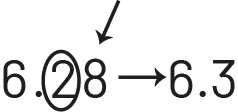B1.5 Round decimal numbers, both terminating and repeating, to the nearest tenth, hundredth, or whole number, as applicable, in various contexts.
Skill: Rounding Decimal Numbers, Both Terminating and Repeating, to the Nearest Tenth, Hundredth, or Whole Number
In most real-life situations, it is not necessary to work with a precise number, since an approximation is just as valid and often more convenient. Junior students need to be able to round using their number sense, which requires analysis and reflection.
A number can be rounded to a pre-determined place value. For example, when purchasing an item for $11.34, the provincial sales tax of 8% is calculated to be $0.907 2. However, we will pay $0.91 because the amount is always rounded to the nearest hundredth of a dollar since thousandths and ten-thousandths of a dollar are not part of our coins.
Students should be presented with a variety of problems that encourage them to think about the effect of rounding on a quantity and to choose how they should round. Should they round to the nearest one, the nearest tenth, or the nearest hundredth? The choice depends on the context, the meaning of the number and the reasons for rounding. For example, a restaurant owner who has tables that are 2.27 m long may, when purchasing tablecloths, round the length to 2.3 m or even 2.5 m to be sure that the tablecloths purchased will be long enough. However, when talking to her employees, she can refer to it as the 2 m table. In short, it is only after an analysis of the context that one can determine how to do the rounding or at what position the rounding should be done.
Reading numbers on a calculator is an essential skill, especially since division with a calculator often results in a quotient with a very long decimal part. In this case, to better understand the quantity displayed, it may be helpful to round a number (for example, round 0.248 953 2 to 0.25) or replace it with a landmark fraction (for example, 0.248 953 2 is about \(\frac{1}{4}\).
Unfortunately, rounding is too often taught using methods that are meaningless because they deal with numbers and not quantity. For example, to round a decimal number to the nearest tenth, students are often taught to identify the digit in the position to be rounded and then consider the digit that follows it. If it is greater than or equal to 5, the identified digit is increased by one and the digits that follow are eliminated.
Example

Research indicates that these traditional rounding methods do not support students to develop an understanding of rounding.
Note: Since rounding a decimal number requires students to use their decimal number sense, it is important that they have had the opportunity to develop it by representing decimal numbers, placing them on a number line and comparing them.
Example
To round 0.6 to the nearest unit, students should recognize that the number 0.6 represents a quantity equivalent to "a little less than 1". They then know that the number is between 0 and 1. They can use their number sense to determine whether 0.6 is closer to 0 or 1. They can use a benchmark number like 0.5 to "see" that 0.6 is closer to 1 or even visualize the location of 0.6 on a number line.

Whichever element of number sense is chosen, students are then able to round 0.6 to 1.

By visualizing the number 0.6 on a straight line, students can conclude that 0.7 is closer to 0.6 than to 0.7 and therefore round up to 0.7.
Source: translated from Guide d’enseignement efficace des mathématiques de la 4e à la 6e année, Numération et sens du nombre, Fascicule 3, Nombres décimaux et pourcentages, p 42-44.
Knowledge: Decimals
A number expressed in decimal notation is composed of two parts, namely the integer part and the decimal part.
Sometimes the decimal part goes on infinitely, such as for the number 3.141 592 65 or 20.333 3…or \(0.\dot{3}\).
Terminating decimal
The decimal part contains a finite number of digits.
Note: Numbers with a terminating decimal part can be represented by decimal fractions.
Example
\(0,5\;\left( {\frac{5}{{10}}} \right)\)
\(1.458\;(\frac{1458}{1000})\)
Non-Terminating and Repeating Decimals
The decimal part contains an infinite number of digits, part of which (the period) repeats indefinitely.
The repeating period is indicated by a horizontal line placed above the repeated digit or group of digits.
Note: Numbers with non-terminating and repeating decimal parts can all be represented by fractions.
Example
\[0.353535...\;{\rm{or}}\;0.\dot{3}\dot{5} \left( {\frac{{35}}{{99}}} \right)\]
\[0,666...\;{\rm{or}}\;0,\dot{6} \left( {\frac{2}{3}} \right)\]
Source: translated from Guide d’enseignement efficace des mathématiques de la 4e à la 6e année, Numération et sens du nombre, Fascicule 3, Nombres décimaux et pourcentages, p. 29.
